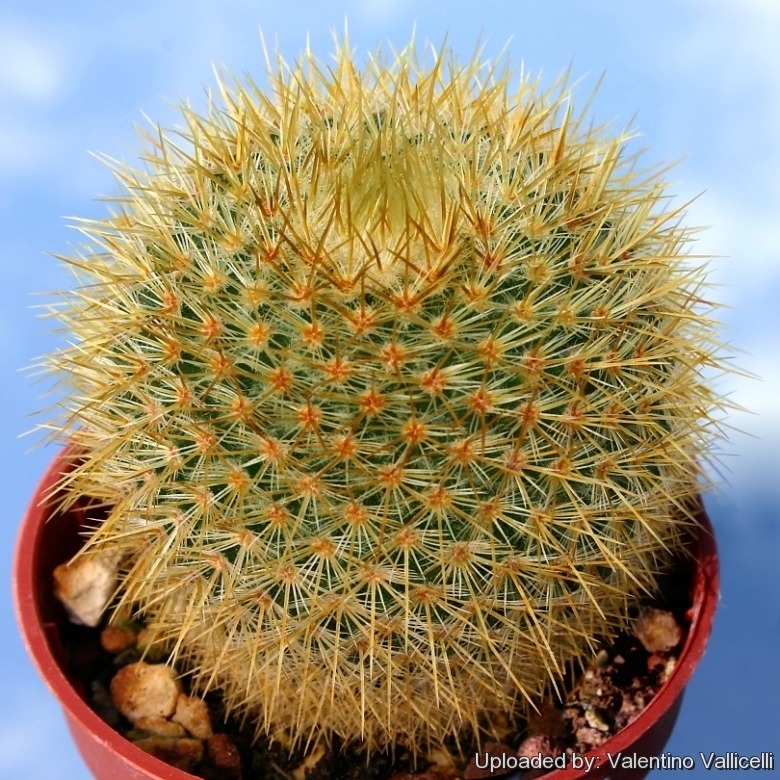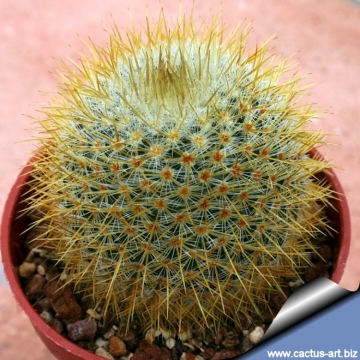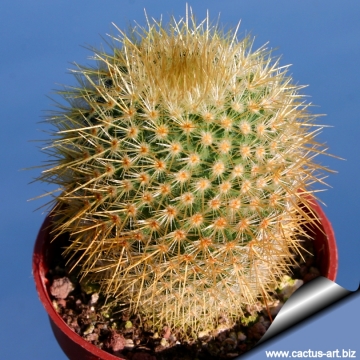Accepted Scientific Name: Mammillaria dixanthocentron subs. flavicentra (Backeb. ex Mottram) U.Guzmán
Cactaceae Syst. Init. 16: 18 (11 Oct. 2003). Remarks: first published in U.Guzmán et al., Catálogo Cact. Mex.: 123 (May 2003), without basionym reference

Mammillaria dixanthocentron var. flavicentra (Mammillaria dixanthocentron subs. flavicentra) Photo by: Valentino Vallicelli
Origin and Habitat: Mexico (Oaxaca, Puebla)
Habitat: Mammillaria flavicentraSN|19100]]SN|19100]] is a facoltative saxicole that can be found either clinging in clefts and crevasses in the rock face and also on small hill, with oak trees, and on the shadier side, under the trees. Altitude 1200- 2700 m.
Synonyms:
See all synonyms of Mammillaria dixanthocentron
back
Accepted name in llifle Database:Mammillaria dixanthocentron Backeb.Descr. Cact. Nov. 3: 8. 1963 nom. inval. type collection not preserved [validated by Mottram Mammill. Index 24 (1980)]Synonymy: 2
Accepted name in llifle Database:Mammillaria dixanthocentron subs. flavicentra (Backeb. ex Mottram) U.GuzmánCactaceae Syst. Init. 16: 18 (11 Oct. 2003). Remarks: first published in U.Guzmán et al., Catálogo Cact. Mex.: 123 (May 2003), without basionym referenceSynonymy: 3
back
Description: Plants solitary, densely covered by short golden spines encircled in white woolly rings.
Stem: Cylindrical or club shaped, up to 18 cm tall and 7-10 cm in diameter. Without latex.
Tubercles: Cylindrical. The axil has few wool at first, later with curly wool.
Central spines: 4 to 6 bright yellow (usually), orangish to dark brown, becoming brownish or whitish, approx 5-10 mm long.
Radials: 22-24 pale yellowish to almost pure white 2 - 4 mm long.
Flowers: Pale pink to red, small up to 5 mm in diameter
Fruits: Yellow below, orange above.
Seeds: Brown.
Subspecies, varieties, forms and cultivars of plants belonging to the Mammillaria dixanthocentron group
Bibliography: Major references and further lectures
1) Edward Anderson “The Cactus family” Timber Press, Incorporated, 2001
2) James Cullen, Sabina G. Knees, H. Suzanne Cubey "The European Garden Flora Flowering Plants: A Manual for the Identification of Plants Cultivated in Europe, Both Out-of-Doors and Under Glass" Cambridge University Press, 11/Aug/2011
3) David R Hunt; Nigel P Taylor; Graham Charles; International Cactaceae Systematics Group. "The New Cactus Lexicon" dh books, 2006
4) John Pilbeam “Mammillaria: the cactus file handbook” Cirio Publishing Services Ltd Dec/30,/1999
5) Arias, S., Valverde, T. & Zavala-Hurtado, A. 2013. Mammillaria dixanthocentron. In: IUCN 2013. "IUCN Red List of Threatened Species." Version 2013.1. <www.iucnredlist.org>. Downloaded on 13 August 2013.
 Mammillaria dixanthocentron var. flavicentra (Mammillaria dixanthocentron subs. flavicentra) Photo by: Cactus Art
Mammillaria dixanthocentron var. flavicentra (Mammillaria dixanthocentron subs. flavicentra) Photo by: Cactus Art Mammillaria dixanthocentron var. flavicentra (Mammillaria dixanthocentron subs. flavicentra) Photo by: Cactus Art
Mammillaria dixanthocentron var. flavicentra (Mammillaria dixanthocentron subs. flavicentra) Photo by: Cactus ArtCultivation and Propagation: Mammillaria dixanthocentronSN|19098]]SN|19098]] subs. flavicentra is an easy-to-grow and easily flowering species, but not a fast grower. Some plants will offset, and moderately large-sized clumps can be produced in a few years.
Water regularly in summer, but do not over-water (rot prone). Use a pot with good drainage and a very porous potting media, and keep dry in winter. Feed with a high potassium fertilizer in summer. Avoid frost. Reputedly sensitive to low temperatures, but less so if kept on the dry side prior to, and during, cold weather. Outside full sun or afternoon shade, inside it needs bright light, and some direct sun. Bright light, encourages flowering and heavy wool and spine production.
Propagation: Direct sow after last frost, or division of larger plants.












